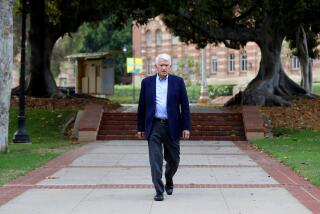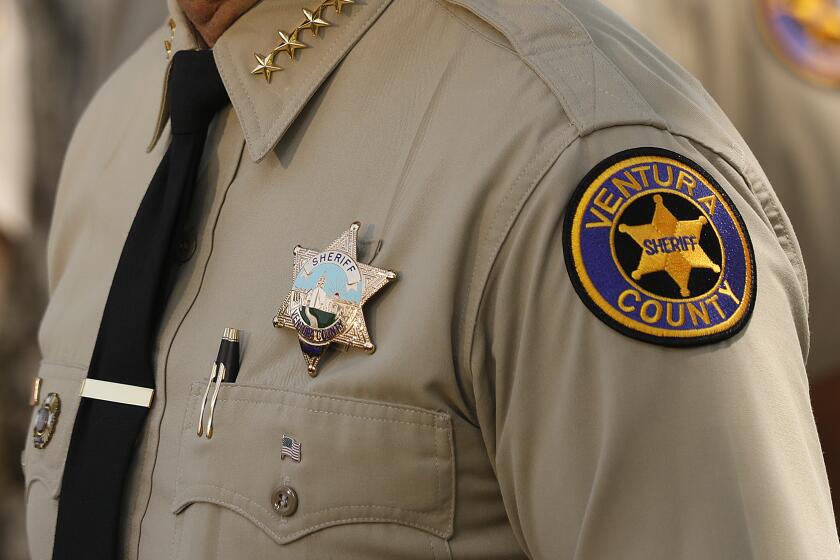Temple’s Growth Plans Protested : Development: Neighbors insist they’ve been kept in the dark about the project’s scope. But Sinai representatives downplay the negative reaction.
Donna Moffitt, who lives two blocks away, first heard rumblings about it in January. Sheila Manning, who lives half a block south, said she got an inkling of it last month. And David Licht, who lives across the street, said he learned what it was all about only four weeks ago.
“I find the whole thing extremely shocking,” Licht said angrily. “It’s going to completely destroy the use of our premises.”
It is the suddenly controversial expansion proposed for the four-story Sinai Temple in Westwood that, if completed, will transform what is already among the nation’s largest Conservative Jewish temples into a facility capable of accommodating up to 250 more preschool and day school students.
As proposed, the complex would sprawl over an entire block, be encircled by an eight-foot-high wall and add 82,000 square feet, almost doubling its current size. Plans also call for building a 528-car underground garage, 23 classrooms, an auditorium and a rooftop playground.
Critics say the expansion will create enough traffic and noise--especially from the playground--to destroy the tranquillity of the area surrounding the temple, at Wilshire and Beverly Glen boulevards. Several zoning changes must be approved before it can proceed, opponents say.
“This project is way too big for the (location),” said Richard Agay, a Westwood resident who opposes the expansion. “It is a horrendous thing to begin making exceptions for.”
*
Manning, who has even attended services at the temple in the past, agrees. “I don’t mind a temple on that corner. I’d like the whole world to be Jewish. But not on the roof.”
Attorneys for the temple say that much of the negative reaction is based on a misunderstanding of the scope of the expansion and the measures being considered to mitigate potential problems.
Lawyer Don Baker, who represents Sinai Temple, said that the primary concern of many residents--added traffic--will actually be alleviated with the construction of the two-level underground garage.
“Even though it will add more traffic . . . overall, the situation will be improved because there will be no traffic stacked up on the street,” Baker said.
Baker said most of the zoning variances required by the project are minor and said the area is already approved for school use as long as the temple obtains a conditional use permit.
*
He also said that, in response to community concern, the temple has agreed to surround the rooftop playground with sound-absorbing walls and to restrict the use of the roof after 6:30 p.m., except on religious holidays. And he said the temple has worked closely for two years with the Westwood Homeowners’ Assn. to elicit residents’ responses.
Yet that is part of the problem, say opponents of the expansion. They allege that some association board members have kept the community largely in the dark concerning the temple’s plans, while generally acceding to its wishes.
Although the present expansion was first envisioned in 1992, after a member bequeathed some of the property to the temple, residents and others say only in the last few months has word about it been disseminated throughout the community.
The only information sent out, they say, was a notice mailed last month of a community meeting to be held between temple representatives and the homeowners association. And that meeting was scheduled only one week before the expansion was debated before the city’s zoning administrator. On Sept. 29, the administrator placed the project on hold for two months.
“I was never made aware that this was such a big project,” said Moffitt, herself an association board member who opposes the expansion. “No one was told.”
*
Jeff Prang, spokesman for Councilwoman Ruth Galanter, who represents many of the residents who live across from the temple, said the councilwoman is not opposed to the project in principle but wishes that the expansion plan had been discussed more openly. “We had not been contacted by the Sinai Temple. We were not brought up to speed to the degree we should have been,” Prang said.
Moffitt and others also say that the homeowners association has been reluctant to take a stand on the issue to avoid opposing Councilman Zev Yaroslavsky, who conditionally supports the expansion and whose district includes the temple. (Yaroslavsky’s district borders Galanter’s along Ashton Avenue, a side street one block south of Wilshire Boulevard.)
According to Moffitt and fellow opponent Art Shapiro, homeowners association president Joyce Foster has never fully opposed the project and at one point discouraged the group’s members from attending the zoning hearing to protest the expansion.
“This (organization) . . . has been very afraid to take active positions,” Shapiro said. “They have recently begun to appreciate that they have not had a good reading of what the community wants.”
Foster and Yaroslavsky deny that attempts were made to keep residents unaware of the project, saying that the issue was brought up at an association meeting in March attended by 150 homeowners, including Yaroslavsky.
Foster called allegations that she discouraged residents from attending the zoning hearing “absolutely untrue.” She said the expansion was first mentioned in an association newsletter sent to members in December, 1993, and that the notice of September’s community meeting was mailed to more than 900 residents.
*
She acknowledged, however, that in both instances details about the size of the project were not mentioned because they weren’t known. Baker, the attorney, said that an architect’s model showing the approximate size of the expansion became available more than a year ago. Although the association has taken a neutral stand on the expansion, Foster said, the group is preparing to mail a questionnaire seeking the community’s views.
“Could (the temple) have done a better job of informing the community?” Foster asked. “Probably. Could (the association) have done a better job? Probably.”
More to Read
Start your day right
Sign up for Essential California for news, features and recommendations from the L.A. Times and beyond in your inbox six days a week.
You may occasionally receive promotional content from the Los Angeles Times.






